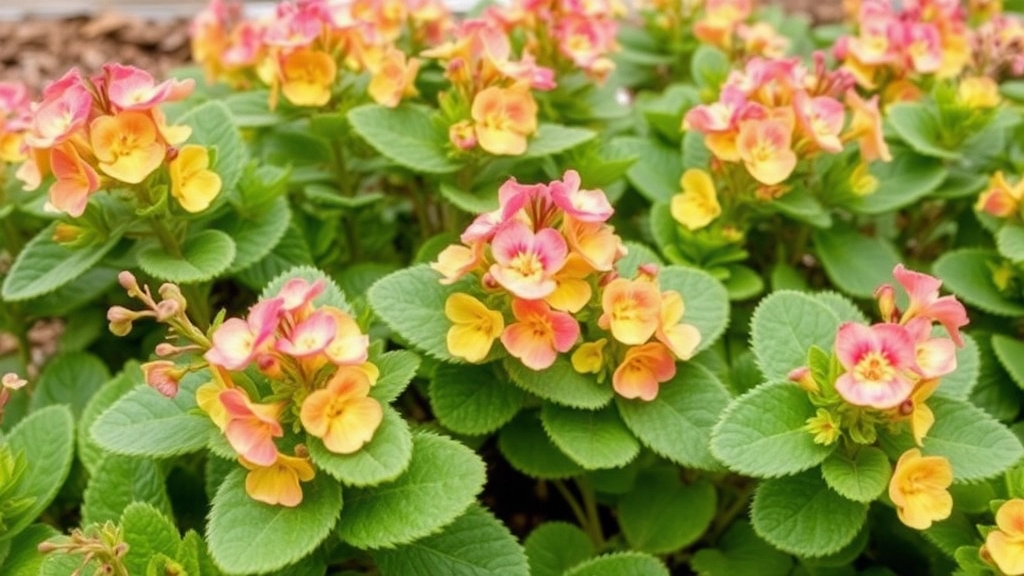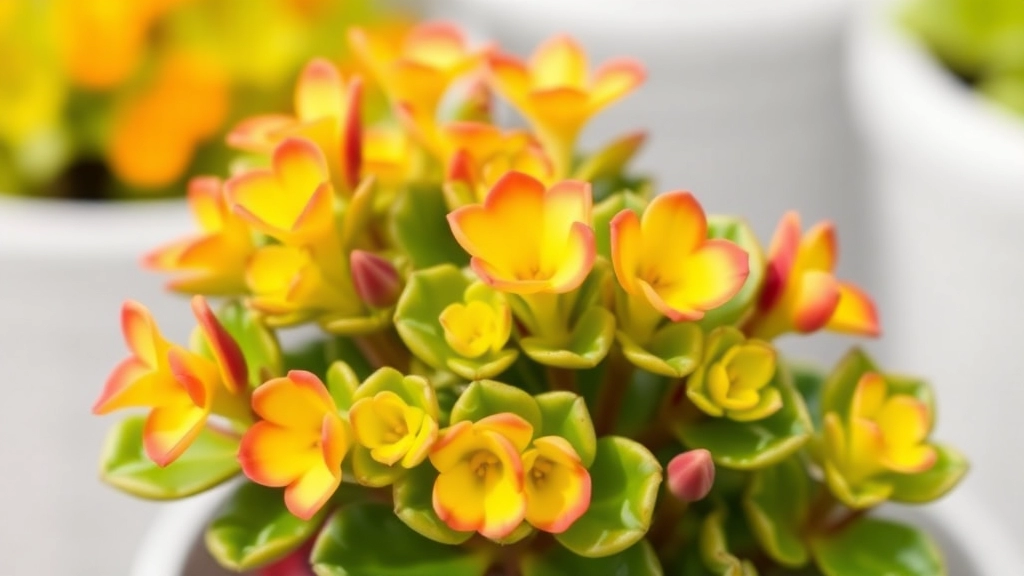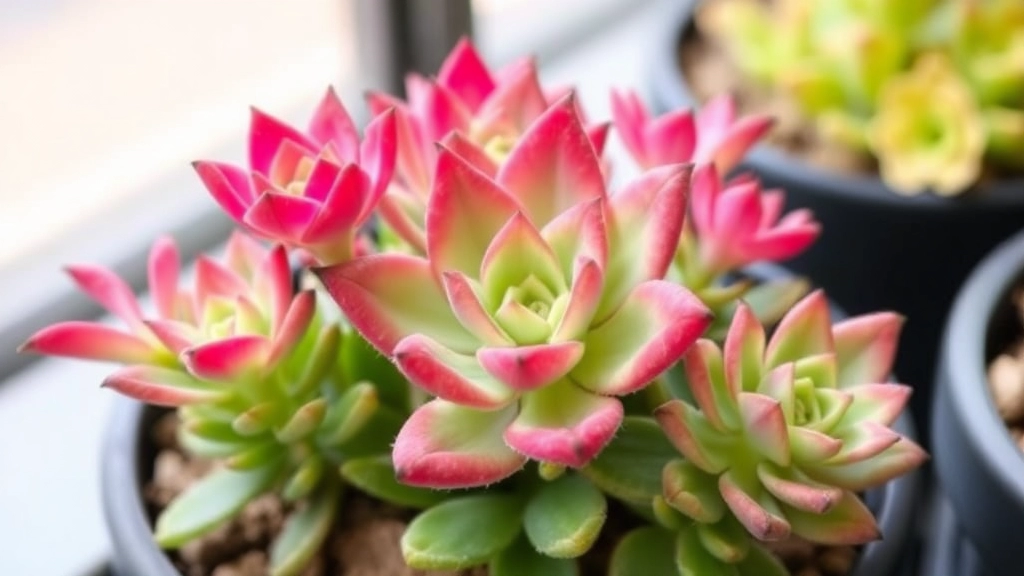Explore the Diverse Kalanchoe Types
Are you curious about the diverse and stunning Succulent Kalanchoe types? You’re in the right place. From vibrant, flowering varieties to unique leaf textures, Kalanchoes are a favourite among both indoor and outdoor gardeners. Let’s dive into the most popular Kalanchoe varieties and discover what makes each one special.
Whether you’re looking for low-maintenance options or exotic species from Madagascar, there’s a Kalanchoe to suit every garden. Learn about their care requirements, propagation tips, and which types thrive in different light conditions. Ready to explore the world of Kalanchoe? Let’s get started!
Most Popular Kalanchoe Varieties for Indoor and Outdoor Gardens
When considering Kalanchoe for your garden, you may wonder which varieties are the most popular for both indoor and outdoor settings.
Kalanchoe is a versatile succulent that brings a splash of colour and character to any space.
Flowering Kalanchoes: Showy Blooms and Vibrant Colors

Have you ever walked into a room and felt instantly uplifted by a splash of colour? That’s the magic of flowering Kalanchoes!
These beauties aren’t just green; they’re a riot of vibrant hues that can brighten up any space, be it indoors or out in the garden.
Why Choose Flowering Kalanchoes?
- Diverse Colour Palette: From fiery reds and sunny yellows to soft pinks and pure whites, there’s a Kalanchoe for every taste.
- Long Blooming Period: Once they start flowering, many varieties can keep those blooms coming for weeks or even months.
- Easy to Care For: They’re not just pretty faces; these plants are relatively low maintenance, perfect for busy folks.
Popular Flowering Varieties
Here are a few standout varieties that you might want to consider:
- Kalanchoe blossfeldiana: This classic variety is known for its clusters of small, vibrant flowers.
- Kalanchoe luciae: Often called the “Paddle Plant,” its unique leaves feature stunning red edges, adding visual interest even when not in bloom.
- Kalanchoe thyrsiflora: Known as the “Mother of Thousands,” it produces tall flower spikes that are a sight to behold.
Tips for Keeping Your Kalanchoes Blooming
- Light: They love bright, indirect sunlight. Too much direct sun can scorch those beautiful leaves.
- Watering: Let the soil dry out between waterings. Overwatering is a common mistake!
- Fertilising: A balanced fertiliser every few weeks during the growing season can help promote those vibrant blooms.
Unique Leaf Shapes and Textures: From Velvet to Spiky
Have you ever wondered why some Kalanchoe varieties stand out not just for their flowers but for their striking foliage?
The unique leaf shapes and textures of Kalanchoe plants can add a captivating element to your indoor and outdoor gardens.
Diverse Leaf Characteristics
- Velvety Leaves:
- Some Kalanchoe varieties, like Kalanchoe tomentosa (Panda Plant), boast soft, fuzzy leaves.
- This texture not only feels delightful but also creates a lush, inviting appearance.
- Spiky Edges:
- On the other hand, Kalanchoe beharensis (Felt Plant) features leaves with a rugged, spiky look.
- These leaves can give your garden a more dramatic flair.
- Curly and Wavy Forms:
- Kalanchoe luciae (Flapjack Plant) showcases flat, paddle-shaped leaves that curl at the edges, adding an interesting dimension to its overall look.
- Variegated Patterns:
- Some varieties present beautiful variegation, with splashes of cream or yellow against deep green.
- This adds visual interest and can brighten up any space.
Why Leaf Texture Matters
- The texture of Kalanchoe leaves can influence the overall aesthetic of your garden.
- Varieties with unique leaves often require different care, making it essential to choose the right ones for your gardening style.
Practical Tips for Care
- Watering:
- Velvety leaves can be more susceptible to rot, so ensure well-draining soil.
- Light Exposure:
- Spiky varieties may thrive in bright, indirect light, while others might prefer partial shade.
Best Kalanchoes for Low Maintenance and Drought Tolerance

When considering Kalanchoe varieties, many of us seek plants that not only beautify our spaces but also require minimal care.
Low maintenance and drought-tolerant Kalanchoes are perfect for busy lifestyles or for those new to gardening.
Here are some of the best options:
- Kalanchoe Blossfeldiana: Known for its vibrant flowers, this variety thrives on neglect. It can go weeks without water, making it ideal for forgetful gardeners.
- Kalanchoe Tomentosa (Panda Plant): With its fuzzy leaves, this succulent is not only charming but also drought-resistant. It requires little watering and can tolerate dry air.
- Kalanchoe Fedtschenkoi (Chandelier Plant): This unique variety features elongated leaves and can handle long periods without water. It’s perfect for those who appreciate a touch of the exotic.
- Kalanchoe Luciae (Paddle Plant): With its striking, paddle-shaped leaves, this succulent is not just visually appealing but also thrives in dry conditions and requires minimal care.
Tips for Care:
- Water sparingly; allow the soil to dry out completely between waterings.
- Place in bright, indirect sunlight to keep them healthy without overwhelming them.
- Use well-draining soil to prevent root rot.
Propagating Kalanchoe: Easy Tips for Growing More Plants
Are you wondering how to expand your Kalanchoe collection without breaking the bank?
Propagating Kalanchoe plants is not only economical but also incredibly rewarding.
Here are some straightforward tips to help you grow more of these beautiful succulents:
1. Choose the Right Time
- Spring or Early Summer: This is the ideal time for propagation, as the plant is in its active growth phase.
2. Select Healthy Leaves or Stems
- Look for plump, healthy leaves or stems.
- Avoid any that show signs of disease or damage.
3. Cutting Technique
- Use a clean, sharp knife or scissors.
- Cut a leaf or stem just below a node (the bump on the stem where leaves grow).
4. Allow to Callus
- Let the cuttings dry for a few hours to form a callus.
- This helps prevent rot when they’re planted.
5. Planting the Cuttings
- Use a well-draining potting mix, preferably a cactus or succulent mix.
- Plant the cuttings about an inch deep.
6. Watering
- Water lightly after planting.
- Allow the soil to dry out completely before watering again.
7. Provide Adequate Light
- Place the pot in a bright, indirect light location.
- Avoid direct sunlight until the cuttings establish roots.
8. Patience is Key
- It may take a few weeks for roots to develop.
- Keep an eye on the cuttings for new growth, which indicates successful rooting.
For more detailed instructions on leaf propagation, check out our Kalanchoe Leaf Propagation Step-by-Step Guide. If you’re interested in learning about different species, our guide to exploring different Kalanchoe species can be very helpful.
Kalanchoe Varieties That Thrive in Different Light Conditions

So, you’ve got your Kalanchoe, but where should you put it?
Light conditions can make or break your plant’s happiness.
Let’s dive into which Kalanchoe varieties do best in different lighting situations.
Bright, Direct Light
Some Kalanchoes absolutely love soaking up the sun.
If you’ve got a bright window, consider these:
- Kalanchoe blossfeldiana: Known for its stunning clusters of flowers, this beauty thrives in full sun.
- Kalanchoe tomentosa: With its fuzzy leaves, it prefers those bright spots to show off its unique texture.
Moderate Light
Not all of us have a sun-drenched home.
For those with moderate light, these varieties will do just fine:
- Kalanchoe luciae: Also known as the paddle plant, it can handle some shade while still looking fabulous.
- Kalanchoe beharensis: This one loves bright, indirect light but can adapt to lower light conditions.
Low Light
If your space doesn’t get much natural light, don’t fret!
There are Kalanchoes that can handle it:
- Kalanchoe marnieriana: This variety can tolerate low light while still adding a splash of greenery to your space.
- Kalanchoe pinnata: Also known as the “air plant,” it’s surprisingly resilient in dimmer environments.
Tips for Light Management
- Rotate Your Plants: To ensure even growth, turn your Kalanchoe every couple of weeks.
- Watch for Signs: Yellowing leaves? That could mean too much sun. Stretching stems? They might be craving more light.
- Adjust Gradually: If moving your plant to a brighter spot, do it slowly to avoid shock.
Exotic Kalanchoe Species Native to Madagascar and Beyond
When exploring the diverse world of Kalanchoe, it’s essential to highlight the exotic species that originate from Madagascar and other unique locales. These plants not only offer stunning aesthetics but also bring fascinating stories and characteristics to your garden.
Why Consider Exotic Kalanchoe?
- Unique Adaptations: Many Kalanchoe species have adapted to harsh environments, making them resilient and interesting additions to your collection.
- Stunning Visual Appeal: The exotic varieties often feature striking foliage and blooms that can elevate any indoor or outdoor space.
Notable Species to Explore
- Kalanchoe tomentosa (Panda Plant)
- Leaf Texture: Soft, fuzzy leaves with a unique silvery-green hue.
- Flowers: Produces tubular yellow-orange flowers, adding a pop of colour.
- Kalanchoe beharensis (Chandelier Plant)
- Growth Habit: Tall, upright growth with large, textured leaves.
- Uses: Perfect for creating a dramatic focal point in gardens.
- Kalanchoe luciae (Flapjack Plant)
- Leaf Shape: Distinctive, flat leaves that resemble pancakes.
- Colouration: Leaves turn a vibrant red in bright sunlight.
- Kalanchoe marnieriana (Mother of Thousands)
- Propagation: Known for its ability to produce plantlets along the edges of its leaves.
- Caution: Can be invasive in some regions, so monitor its spread.
Care Tips for Exotic Kalanchoe
- Light Requirements: Most of these species thrive in bright, indirect light.
- Watering: Allow the soil to dry out between waterings to prevent root rot.
- Soil: Use well-draining soil to support healthy growth.
Toxicity of Kalanchoe: What to Know for Pets and Children

So, you’ve fallen in love with Kalanchoes and want to bring a splash of colour into your home or garden. But before you do, let’s chat about something crucial: their toxicity.
Many of us have pets or little ones running around, and it’s only natural to worry about what’s safe for them.
Here’s the scoop:
- Toxic Compounds: Kalanchoes contain compounds called bufadienolides. These can be harmful if ingested.
Symptoms in Pets:
If a dog or cat munches on a Kalanchoe, they might experience:
- Vomiting
- Diarrhoea
- Lethargy
- In severe cases, it can lead to heart problems.
Symptoms in Children:
While it’s less common for kids to nibble on plants, if they do, watch out for:
- Stomach upset
- Nausea
- Dizziness
What to Do:
If you suspect your furry friend or little one has eaten part of a Kalanchoe, it’s best to contact a vet or doctor immediately.
Safety Tips:
- Placement: Keep your Kalanchoes out of reach. High shelves or hanging baskets can do the trick.
- Education: Teach kids about which plants are safe and which aren’t. It’s a good habit to get into!
In short, while Kalanchoes are stunning, a little caution goes a long way in keeping your loved ones safe.
As we explore the fascinating world of Kalanchoe, it’s essential to highlight the rare and unusual hybrids that have captured the hearts of collectors.
Are you looking to elevate your plant collection with unique varieties?
Kalanchoe hybrids can offer stunning aesthetics and intriguing characteristics that set them apart from more common species.
Here are some notable hybrids to consider:
– **Kalanchoe ‘Fang’**: This hybrid features striking, spiky leaves that resemble a dragon’s teeth. Its unusual appearance makes it a conversation starter in any plant collection.
– **Kalanchoe ‘Chocolate Soldier’**: With its rich, dark foliage and unique texture, this hybrid is a visual treat. It’s perfect for those who appreciate plants with character.
– **Kalanchoe ‘Kalanchow’**: Known for its vibrant blooms and compact growth, this hybrid thrives indoors and outdoors, making it a versatile choice.
– **Kalanchoe ‘Marmalade’**: This hybrid boasts leaves that transition from green to a warm orange hue, especially in bright light. It’s a stunning addition to any garden.
When seeking out these rare hybrids, consider the following tips:
– **Research Local Nurseries**: Many local plant shops may carry unique hybrids that aren’t found in larger stores.
– **Join Plant Collectors Groups**: Engaging with fellow enthusiasts can lead to valuable insights and potential plant swaps.
– **Attend Plant Shows**: Events dedicated to plants often feature rare varieties and knowledgeable vendors.
These hybrids not only provide visual interest but also contribute to the biodiversity of your collection. For more detailed care instructions, check out our [Kalanchoe Chocolate Soldier Care Guide](https://planthq.org/kalanchoe-chocolate-soldier-care-expert-tips-guide/) and learn about the [Medicinal Benefits of Kalanchoe Daigremontiana](https://planthq.org/medicinal-benefits-of-kalanchoe-daigremontiana-explained/).
FAQs on Succulent Kalanchoe Types
What makes flowering Kalanchoes special?
Flowering Kalanchoes are known for their vibrant hues and long blooming periods. They can brighten up any space, indoors or outdoors, and are relatively easy to care for.
Which are some popular flowering Kalanchoe varieties?
Some popular flowering varieties include:
- Kalanchoe blossfeldiana: Known for its clusters of small, vibrant flowers.
- Kalanchoe luciae: Often called the “Paddle Plant,” with unique leaves featuring stunning red edges.
- Kalanchoe thyrsiflora: Known as the “Mother of Thousands,” it produces tall flower spikes.
How should I care for my flowering Kalanchoes?
To keep your Kalanchoes blooming, ensure they get bright, indirect sunlight, allow the soil to dry out between waterings, and use a balanced fertilizer during the growing season.
What are the best Kalanchoes for low maintenance and drought tolerance?
Some of the best low-maintenance and drought-tolerant Kalanchoes include:
- Kalanchoe Blossfeldiana
- Kalanchoe Tomentosa (Panda Plant)
- Kalanchoe Fedtschenkoi (Chandelier Plant)
- Kalanchoe Luciae (Paddle Plant)
What are the light requirements for different Kalanchoe varieties?
Different Kalanchoe varieties thrive in various light conditions:
Bright, Direct Light
Varieties like Kalanchoe blossfeldiana and Kalanchoe tomentosa thrive in full sun.
Moderate Light
Varieties like Kalanchoe luciae and Kalanchoe beharensis do well in bright, indirect light but can adapt to moderate light conditions.
Low Light
Varieties like Kalanchoe marnieriana and Kalanchoe pinnata can tolerate low light.
How can I manage light for my Kalanchoes?
To manage light effectively:
- Rotate Your Plants: Turn your Kalanchoe every couple of weeks for even growth.
- Watch for Signs: Yellowing leaves may indicate too much sun, while stretching stems suggest a need for more light.
- Adjust Gradually: Move your plant to a brighter spot slowly to avoid shock.
Are Kalanchoes toxic to pets and children?
Yes, Kalanchoes contain toxic compounds called bufadienolides, which can be harmful if ingested by pets or children.
Symptoms in Pets
If a pet ingests Kalanchoe, they may experience vomiting, diarrhea, lethargy, and in severe cases, heart problems.
Symptoms in Children
If a child ingests Kalanchoe, they may experience stomach upset, nausea, and dizziness.
What should I do if my pet or child ingests Kalanchoe?
If ingestion is suspected, contact a vet or doctor immediately for advice and treatment.
How can I keep my loved ones safe around Kalanchoes?
To ensure safety:
- Placement: Keep Kalanchoes out of reach on high shelves or in hanging baskets.
- Education: Teach children about which plants are safe and which are not.
References
-
Growing Kalanchoe Indoors: Tips and Tricks
-
Kalanchoe: How to Grow and Care for Kalanchoe
-
Kalanchoe: Plant Care and Growing Guide
